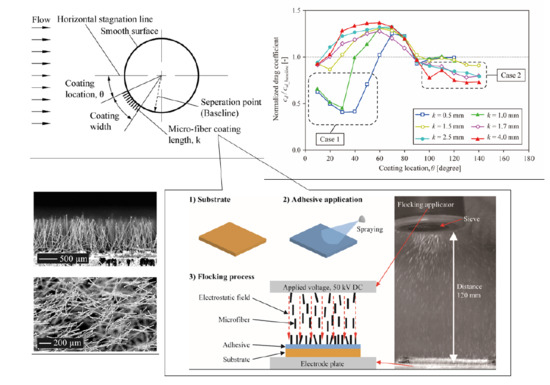Microfiber Coating for Flow Control over a Blunt Surface
Abstract
:1. Introduction
2. Materials and Methods
2.1. Fabrication of Microfiber Coating
2.2. Wake Survey
2.3. Drag Estimation
3. Results
3.1. Drag Estimation
3.2. Wake Survey
4. Conclusions
Author Contributions
Funding
Conflicts of Interest
References
- Bishop, R.E.D.; Hassan, A.Y. The lift and drag forces on a circular cylinder in a flowing fluid. Proc. R. Soc. Lond. Ser. A Math. Phys. Sci. 1964, 277, 32–50. [Google Scholar]
- Prasad, A.; Williamson, C.H.K. A method for the reduction of bluff body drag. J. Wind Eng. Ind. Aerodyn. 1997, 69–71, 155–167. [Google Scholar] [CrossRef]
- Matsumoto, M. Vortex shedding of bluff bodies: A review. J. Fluids Struct. 1999, 13, 791–811. [Google Scholar] [CrossRef]
- Choi, H.; Jeon, W.-P.; Kim, J. Control of Flow Over a Bluff Body. Annu. Rev. Fluid Mech. 2008, 40, 113–139. [Google Scholar] [CrossRef] [Green Version]
- Thomas, F.O.; Kozlov, A.; Corke, T.C. Plasma Actuators for Cylinder Flow Control and Noise Reduction. AIAA J. 2008, 46, 1921–1931. [Google Scholar] [CrossRef]
- Kozlov, A.V.; Thomas, F.O. Bluff-Body Flow Control via Two Types of Dielectric Barrier Discharge Plasma Actuation. AIAA J. 2011, 49, 1919–1931. [Google Scholar] [CrossRef]
- Wieselsberger, C. Der luftwiderstand von kugeln. Z. Flugtech. Motorluftschiffahrt 1914, 5, 140–145. [Google Scholar]
- Fage, A. The effects of turbulence and surface roughness on the drag of a circular cylinder. Rep. Memo. 1929, 1283, 1–8. [Google Scholar]
- James, D.F.; Truong, Q.-S. Wind load on cylinder with spanwise protrusion. J. Eng. Mech. Div. 1972, 98, 1573–1589. [Google Scholar]
- Nebres, J.; Batill, S. Flow about a circular cylinder with a single large-scale surface perturbation. Exp. Fluids 1993, 15, 369–379. [Google Scholar] [CrossRef]
- Bearman, P.W.; Harvey, J.K. Control of circular cylinder flow by the use of dimples. AIAA J. 1993, 31, 1753–1756. [Google Scholar] [CrossRef]
- Choi, J.; Jeon, W.-P.; Choi, H. Mechanism of drag reduction by dimples on a sphere. Phys. Fluids 2006, 18, 041702. [Google Scholar] [CrossRef] [Green Version]
- Lin, J.C.; Robinson, S.K.; McGhee, R.J.; Valarezo, W.O. Separation control on high-lift airfoils via micro-vortex generators. J. Aircr. 1994, 31, 1317–1323. [Google Scholar] [CrossRef]
- Lin, J.C. Review of research on low-profile vortex generators to control boundary-layer separation. Prog. Aerosp. Sci. 2002, 38, 389–420. [Google Scholar] [CrossRef]
- Bruneau, C.-H.; Mortazavi, I. Control of Vortex Shedding Around a Pipe Section Using a Porous Sheath. Int. J. Offshore Polar Eng. 2006, 16, 7. [Google Scholar]
- Bhattacharyya, S.; Singh, A.K. Reduction in drag and vortex shedding frequency through porous sheath around a circular cylinder. Int. J. Numer. Methods Fluids 2011, 65, 683–698. [Google Scholar] [CrossRef]
- Klausmann, K.; Ruck, B. Drag reduction of circular cylinders by porous coating on the leeward side. J. Fluid Mech. 2017, 813, 382–411. [Google Scholar] [CrossRef]
- Walsh, M.J. Riblets as a Viscous Drag Reduction Technique. AIAA J. 1983, 21, 485–486. [Google Scholar] [CrossRef]
- Bechert, D.; Reif, W. On the Drag Reduction of the Shark Skin. In Proceedings of the 23rd Aerospace Sciences Meeting; American Institute of Aeronautics and Astronautics: Reston, VA, USA, 1985. [Google Scholar]
- Lee, S.-J.; Lim, H.-C.; Han, M.; Lee, S.S. Flow control of circular cylinder with a V-grooved micro-riblet film. Fluid Dyn. Res. 2005, 37, 246–266. [Google Scholar] [CrossRef]
- Favier, J.; Dauptain, A.; Basso, D.; Bottaro, A. Passive separation control using a self-adaptive hairy coating. J. Fluid Mech. 2009, 627, 451–483. [Google Scholar] [CrossRef] [Green Version]
- Brucker, C. Interaction of flexible surface hairs with near-wall turbulence. J. Phys. Condens. Matter 2011, 23, 18. [Google Scholar] [CrossRef] [PubMed]
- Hasegawa, M.; Sakaue, H. Microfiber Coating for Drag Reduction by Flocking Technology. Coatings 2018, 8, 464. [Google Scholar] [CrossRef]
- Sumer, B.M.; Fredsoe, J. Hydrodynamics Around Cylindrical Structures; Advanced Series on Ocean Engineering; World Scientific: Singapore, 2006; Volume 26, ISBN 978-981-270-039-1. [Google Scholar]
- Bolgen, S.W. Flocking Technology. J. Coat. Fabr. 1991, 21, 123–131. [Google Scholar] [CrossRef]
- Woodruff, F.A. Developments in Coating and Electrostatic Flocking. J. Coat. Fabr. 1993, 22, 290–297. [Google Scholar] [CrossRef]
- Barlow, J.B.; Rae, W.H.; Pope, A.; Pope, A. Low-Speed Wind Tunnel Testing; Wiley: Hoboken, NJ, USA, 1999; ISBN 9780471557746. [Google Scholar]
- Braslow, A.L.; Knox, E.C. Simplified Method for Determination of Critical Height of Distributed Roughness Particles for Boundary-layer Transition at Mach Numbers from 0 to 5; National Advisory Committee for Aeronautics: Washington, WA, USA, 1958. [Google Scholar]
- Igarshi, T. Characteristics of the Flow around Two Circular Cylinders Arranged in Tandem: 1st Report. Bull. JSME 1981, 24, 323–331. [Google Scholar] [CrossRef]







| Microfiber Length, k [mm] | Relative Length, k/D [%] | Coating Location, θ [°] |
|---|---|---|
| 0.54 ± 0.05 | 1.1 | 10 to 120 |
| 0.91 ± 0.03 | 1.8 | 10 to 120 |
| 1.52 ± 0.09 | 3.0 | 10 to 140 |
| 1.67 ± 0.16 | 3.3 | 10 to 140 |
| 2.53 ± 0.04 | 5.1 | 10 to 140 |
| 4.52 ± 0.13 | 9.0 | 10 to 140 |
© 2019 by the authors. Licensee MDPI, Basel, Switzerland. This article is an open access article distributed under the terms and conditions of the Creative Commons Attribution (CC BY) license (http://creativecommons.org/licenses/by/4.0/).
Share and Cite
Hasegawa, M.; Sakaue, H. Microfiber Coating for Flow Control over a Blunt Surface. Coatings 2019, 9, 664. https://doi.org/10.3390/coatings9100664
Hasegawa M, Sakaue H. Microfiber Coating for Flow Control over a Blunt Surface. Coatings. 2019; 9(10):664. https://doi.org/10.3390/coatings9100664
Chicago/Turabian StyleHasegawa, Mitsugu, and Hirotaka Sakaue. 2019. "Microfiber Coating for Flow Control over a Blunt Surface" Coatings 9, no. 10: 664. https://doi.org/10.3390/coatings9100664







